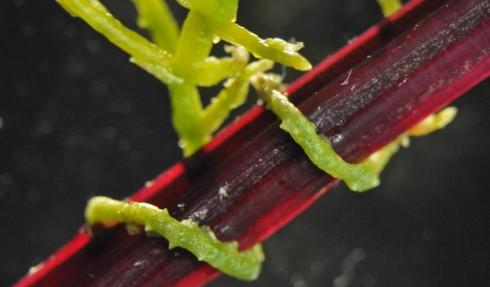The ‘vampire plant’ is even more nefarious than scientists thought
When parasitic plants, such as the dodder, attack plants like the sugar beet shown here, there is a vast exchange of genetic information between the plants, a Virginia Tech researcher has discovered.
A parastic vine nicknamed the "vampire plant" sounds scary enough, but new research is finding that the dodder plant is even more devious than previously thought.
The dodder earned its sinister nickname for the way it sucks nutrients and water from its hosts. Researchers have known for years about its theft of water, sugar and small molecules from host plants, says James Westwood, a professor of plant pathology, physiology and weed science at Virginia Tech. Now Westwood says they're finding that the dodder removes large molecules, too — specifically, messenger RNA.
“The analogy I like to use is that the RNAs are like internal memos,” he explains. “They're sent from the ‘executive office’ to the ‘production floor’ and they give directions. Their only purpose is to transmit that information, and then they are shredded. For these to be stolen by the parasite is really interesting.”
If the dodder is exchanging those molecules, Westwood says, that "raises interesting hypotheses about how the paristic plant might be controlling or interacting with the host." He and his team explore the meanings of the discovery in a new paper published in the journal Science.
The most intriguing idea is that dodder may not only be stealing these memos — it may be writing some of its own: "Not only does the dodder take information from the host,” Westwood says, “but it's either leaking or sending its own messenger RNA’s into the host — and that could be really nefarious, because these information molecules could be telling the host what to do.”
There has to be coordinated growth for the host cell to feed the parasite, Westwood says, so these messages could be saying things like, "Make more sugar," or "Stand down the defenses." In a sense, the parasite plant is hijacking its host and taking over its cell function. “They are convincing the host plants to behave the way they want them to behave,” Westwood says.
Other parasitic plants use similar tactics, Westwood says: the vine wraps itself around the stem of the host plant and forms tight coils. At the points of contact between the vine and the host, it produces structures called haustoria. These invade the host and tap into its vascular system — hence, the vampire analogy.
In time-lapse video, the dodder seems to be searching for a victim to attack. All plants, especially vine plants, make this kind of movement, Westwood says, but the dodder plant "almost seems to be smelling the air,” Westwood says. “They can detect chemical signals given off by the host … and they grow directionally. They don't take a chance: they aim toward the host. They're very smart in their own brainless way.”
This story is based on an interview that aired on PRI's Science Friday with Ira Flatow.
The World is an independent newsroom. We’re not funded by billionaires; instead, we rely on readers and listeners like you. As a listener, you’re a crucial part of our team and our global community. Your support is vital to running our nonprofit newsroom, and we can’t do this work without you. Will you support The World with a gift today? Donations made between now and Dec. 31 will be matched 1:1. Thanks for investing in our work!
